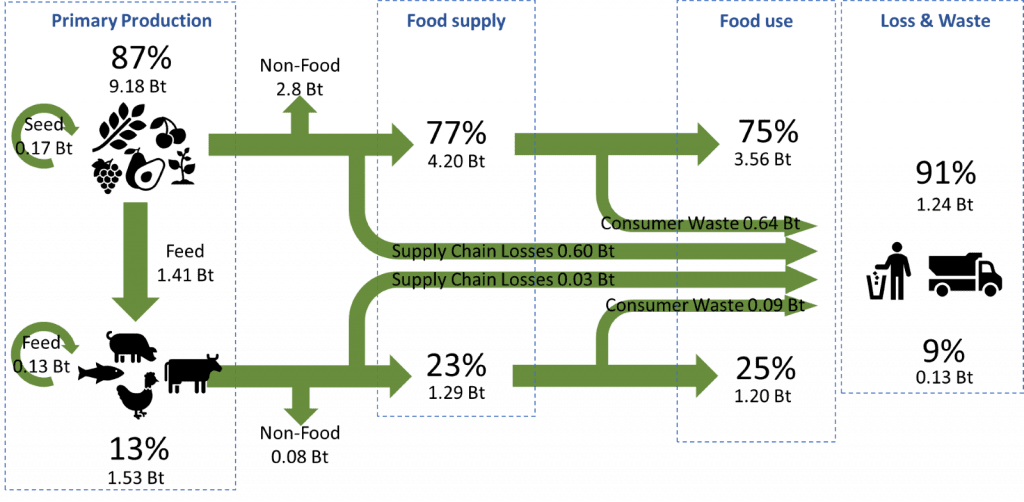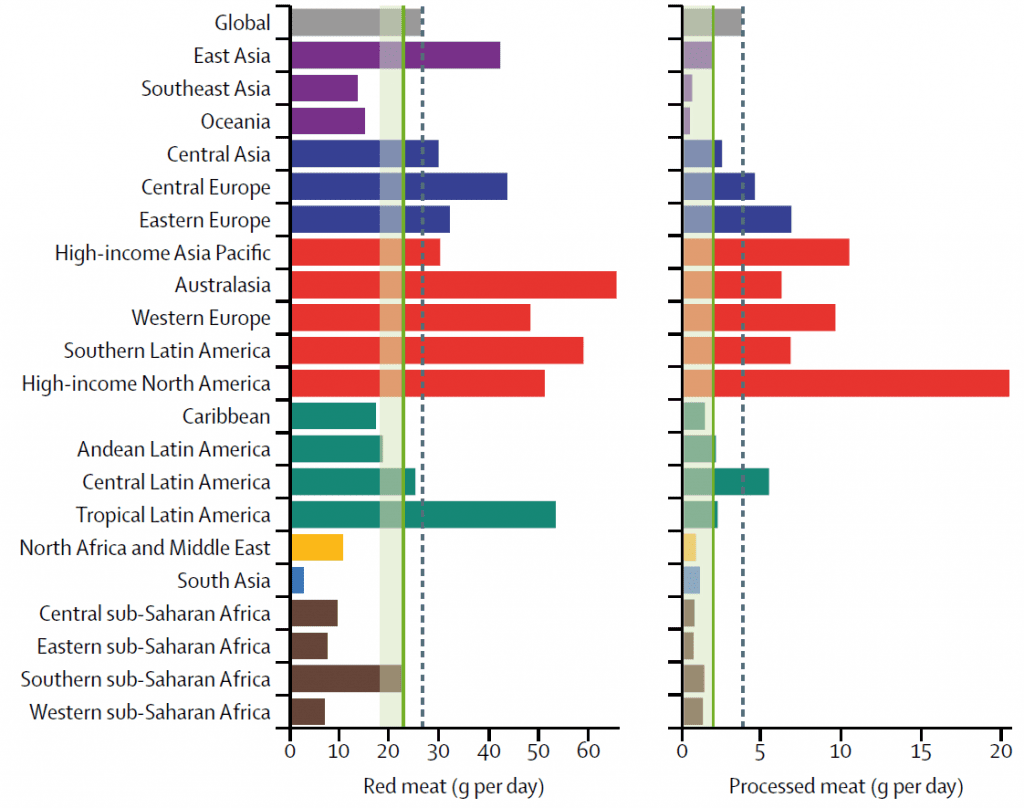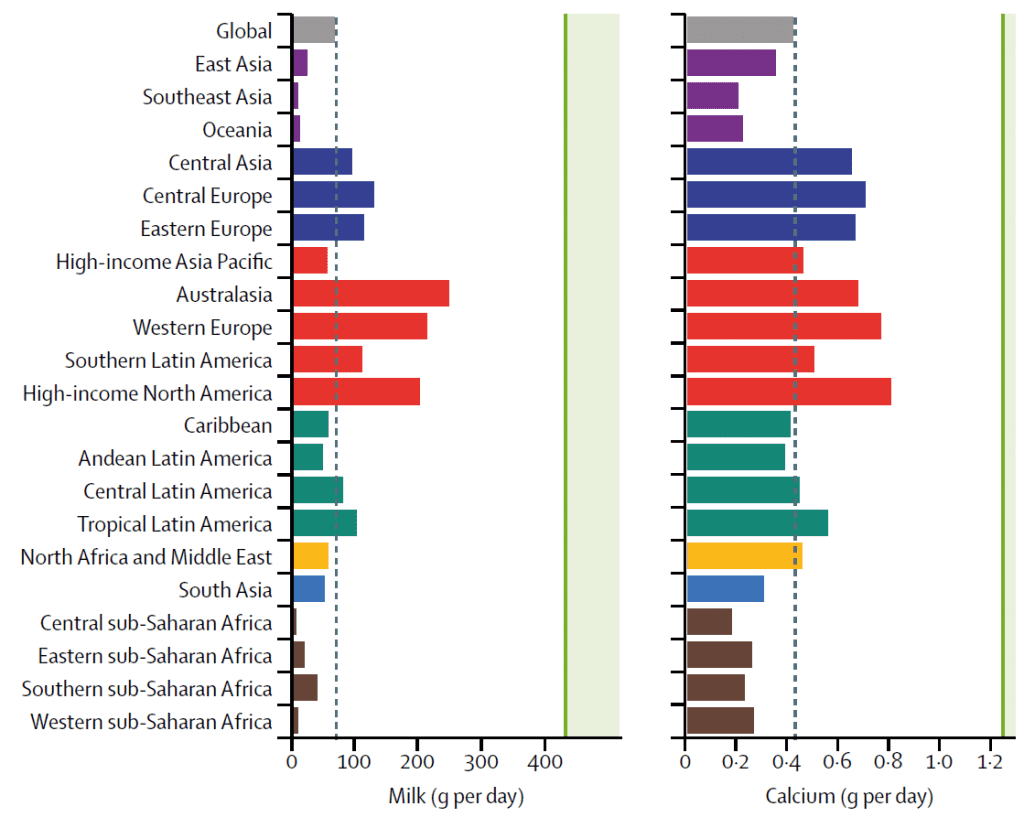18 Nov Need or Greed?
Adjunct Professor of Massey University and the Riddet Institute and Fonterra Chief Science and Technology Officer, Jeremy Hill, last week contributed to COP26 on the future of sustainable food systems. SNi research featured heavily in this contribution. Prof Hill outlines some important aspects of today’s food system that are poorly understood, and examines the role of meat, dairy and future protein sources in achieving sustainable nutrition.
The global food system
SNi work on global food biomass production and nutrient availability has shown that the current global food system is already plant-based, but with animal-sources of nutrition playing a vital role in overall nutrient provision. Of the 10.6 billion tonnes of food biomass that left the world’s farms and oceans in 2018, 9.2 billion tonnes (87%) was plant material and 1.4 billion tonnes (13%) was animal-sourced. On a global basis we have mapped the flow of this food biomass, shown in the below figure.

Biomass flows through the global food system.
On a simple biomass basis, 1.4 billion tonnes (15%) of human-edible plant biomass leaving the world’s farms was used as feed for animals, to supplement non-human-edible feed such as grass. This was used to produce the 1.5 billion tonnes of animal-sourced food leaving the world’s farms.
At face value, this does not look very efficient, considering the environmental impact of animal production systems. However, this hides the different nutrient contributions that come from plant and animal sources of nutrition, land use suitability for cropping and major differences in the supply chain losses, waste, and non-food uses of the plant and animal contributions to the global food system.
The fact that only 1.4 billion tonnes of human-edible plant food biomass was used to feed animals also highlights that a significant proportion of animal nutrition does not come from human-edible plant material but from straws, silages, pastures, food waste, and so on. The scientific publication: Livestock: on our plates or eating at our table? provides an excellent overview of the feed versus food debate and found that, although livestock consume one third of global grain production, 86% of the biomass consumed by farmed animals is inedible for humans.
75% percent of what is eaten by the global population comes from plants; but also, 91% of post-farm food losses and waste comes from plants.
Of the food material entering the food chain, 86% of animal-sourced food material produced is consumed but only 47% of the plant-sourced food material.
Looking at global food supply, flows, consumption, and losses gives a different perspective on efficiencies. The food system is already plant-based and from the perspective of production, consumption, and waste, animal sources of food have very efficient aspects. But that is the case for food biomass; what about nutrition?
Nutrition supply and demand
We often hear about the “need” to produce more protein to meet the growth in demand for protein-rich foods. This includes the “need” for more meat and that using current systems to produce this amount of meat is not sustainable. We have recently shown using the DELTA Model for global nutrient provision that the world not only produces enough protein to cater to the nutritional requirements of our current global population (see below figure), but that current production could meet the protein and indispensable amino acid requirements of a population projected to reach almost 10 billion by 2050. The issue is not production but distribution, access, and affordability of protein.

A value of 1 indicates that global nutrient availability exactly meets requirement, less than 1 a shortage, and greater than 1 a surplus. The coloured bars show the global average nutrient availability. Red bars indicate nutrients with insufficient availability, orange bars are just meeting requirement, and green bars clearly exceed the target. The error bars show the range in nutrient availability between the 10 th and 90 th population percentiles based on country level averages.
In contrast to the global availability of protein, there are currently large gaps between global need and global supply of certain micronutrients that will only get bigger unless the food system changes to address these gaps. Critically, animal-sourced foods and oil crops are currently the major sources of key micronutrients in deficit, such as calcium and vitamin E, with animal-sourced foods also important sources of globally limited nutrients such as iron, zinc, potassium, vitamins A, B2, and B12.
For most nutrients there is a wide variation in their availability between countries, and clearly for some countries, access to sufficient nutrition drops below target intake (see above figure). These gaps have the potential to increase with an increasing global population and especially if, as is currently the case, the population increase is in countries where access to nutrition is already below target requirements.
‘Meating’ needs?
Thinking about the current growth in meat production: how much of this is meeting needs rather than catering to the greedy? Here I use the term “greed” in the context of eating a particular food beyond the point of its contribution to a balanced diet and nutrient requirements, with no implication of moral judgement. Nevertheless, it is hard to argue that this behaviour is in keeping with sustainability, as over-consumption can be considered a form of food and nutrient waste.
According to the FAO, global meat production grew 44% over the period 2000-2019. But how much of this growth is servicing need rather than greed? How many of the existing or new consumers are eating meat above the recommended target intake? Quite a considerable number according to The Global Burden of Disease Study (see below figure). Yet, as with overall protein availability, the consumption of meat is geographically uneven.

The dotted line represents global average consumption levels and shaded green area the uncertainty in the level of optimal intake. Reproduced from Afshin et al. 2019 under the CC BY 4.0 license.
Milking the planet?
At 844 million tonnes, milk represents 60% of the animal-sourced global food biomass. So how does its consumption compare with meat? Clearly the picture for milk is very different, as is calcium intake (see below figure), with the per capita consumption of milk falling short of optimal intake in all regions of the world.

The dotted line represents global average consumption levels and shaded green area the uncertainty in the level of optimal intake. Reproduced from Afshin et al. 2019 under the CC BY 4.0 license.
Our work at SNi has found that although milk represents 60% of animal-food biomass, milk is less than 8% of the total food biomass leaving the farm gate, and contributes 49% of the calcium, 24% of vitamin B2, 22% of vitamin B12, 15% of vitamin A, 12% of the protein, up to 18% of the indispensable amino acids, and makes a significant contribution to a range of other nutrients consumed by the global population. Moreover, at only 7% of global dietary energy, milk is not only nutrient rich (content and range of nutrients) but also nutrient dense (content and range of nutrients compared to number of calories).
Clearly milk plays an important role in global nutrition and from a consumption versus recommended intake perspective, it would appear we should be producing more milk not less. But that’s nutrition and health, what about environment?
Although the food system in its entirety is estimated to contribute 20-30% of total GHG on a carbon equivalent basis, dairy’s contribution is 2-3%. Considering milk’s global nutrient contribution, its nutrient richness and nutrient density, dairy looks like a pretty good deal. A good deal, but not a perfect deal and, for the very reason that it is so important to global nutrition, we should focus on making large improvements to the efficiency of milk production and its environmental footprint, especially if we need to produce more rather than less milk in the future.
Alternative Reality?
Of course, another often publicised approach would be to attempt to replace milk and other animal-sourced foods with alternative sources of nutrition that have lower environmental footprints.
As discussed earlier in the article, the issue with global nutrition is largely about affordability and access, i.e. what the global population needs. As such ‘plant-based’ alternatives and new technologies, such as precision fermentation or mammalian cellular production, should aim to produce substitutes in more affordable and accessible formats that provide the same nutritional benefits as existing plant and/or animal sources of those nutrients.
We would also argue that improvements to the productivity and sustainability of existing plant-sourced or animal-sourced foods should look to do the same.
Whether consumers of such alternative and novel foods are actually doing good rather than just feeling good about what they are doing will depend on several factors.
- What does this consumption mean for global food biomass production, losses, and waste?
- Are the alternatives as nutritious as the foods they are substituting?
- Do the alternatives have lower environmental footprints for water, land use etc. as well as just greenhouse gases per unit of nutrition?
- Are the alternatives consumed responsibly to the point of need and not well above what is required, as a result of “greed”?
- Are the alternatives cheaper to produce and distribute and can they be sold in such a way that it increases global access to nutrition?
- Will companies producing alternative proteins transform the global food system by democratising it and providing more access to affordable nutrition? Or will they concentrate control and remain beyond the reach of many global consumers?
SNi was established to help create a better understanding of the global food system and particularly the critical issue of how it can provide all the nutrients required by everyone on the planet. Its purpose is to help people explore what changes to the system may be possible, but also what will be practical.
If we are to have a sustainable world and, by implication, a sustainable food system, then there is certainly the need for radical change. However, we do not subscribe to the view that all aspects of the food system need to be disrupted. Radical improvements in the existing food production system will be equally, if not more important, than radical changes to the food production system.
But to be clear there will be no room for laggards, and we do see an important role for new ways of producing the nutrients we require, such as precision fermentation, but that these will be complementary to rather than totally disruptive to existing food chains. In doing so everyone has the right to choose the diets they want to follow and certainly for those that can afford to do so, have broad options for what they can choose.
When it comes to the food system, perhaps the most important changes of all are the changes we make ourselves. Here I would start with consuming closer to what we need and cutting back on the greed.
Photo by Spencer Davis on Unsplash






